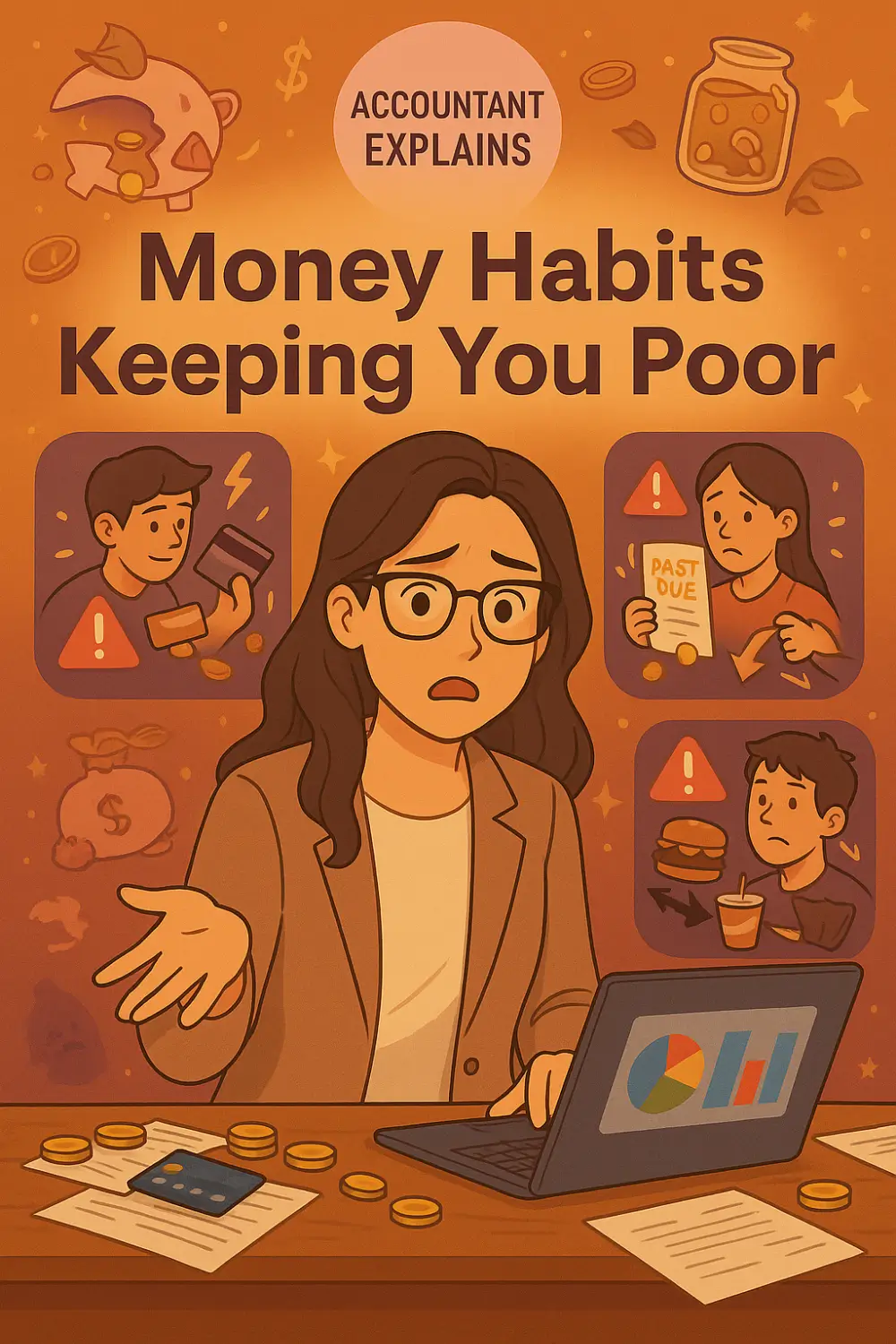After more than a decade working in finance, accounting, and investment banking, I’ve seen one truth play out time and time again: It’s not how much you make, it’s how you manage it.
You could earn six figures and still live paycheck to paycheck if your money habits are working against you. And the good news? Bad habits can be broken, and replaced with smarter, wealth-building ones.
9 Money Habits Keeping Moms Broke

Here are 9 money mistakes that could be silently draining your bank account, and exactly how to fix them before they cost you even more.
1. Paying Yourself Last
The Problem
Most people pay their rent, utilities, subscriptions, and that surprise Uber Eats order, then think about saving.
But here’s the kicker: by the time they get to savings, there’s usually nothing left.
Saving what’s “left over” is the financial equivalent of living off scraps, and it’s why so many people stay stuck in the paycheck-to-paycheck cycle.
The Fix
Flip the script: pay yourself first.
Set up an automatic transfer that moves at least 10% of your income into a dedicated savings account the moment you get paid.
- Make it untouchable
- Label it clearly (e.g., “Freedom Fund” or “Future Me”)
- Treat it like rent, it’s non-negotiable
🧠 Keynote: Prioritize yourself financially.
Your wealth deserves first priority, not your bills, not your spending, you.
You can’t build a future if you’re always funding everyone else’s first.
2. Getting Comfortable With Bad Debt
The Problem
It starts small, swiping your card for coffee, a new outfit, or a birthday gift.
But over time, bad debt becomes normal, and you find yourself funding your lifestyle on borrowed money with sky-high interest rates.
Credit cards often carry 20%+ APR, and that $40 dinner could end up costing you double if you let the balance sit.
High-interest debt is like quick sand, the longer you’re in it, the harder it is to climb out.
The Fix
Here’s the golden rule: If you can’t afford to pay cash, don’t buy it with credit.
Use credit only for what you can pay off in full every month, no exceptions.
- Avoid carrying balances
- Cancel impulse buys that only look affordable when they’re delayed
- Focus on becoming debt-averse, not just debt-tolerant
🧠 Keynote: Bad debt robs your future.
Interest doesn’t just drain your wallet, it delays your goals.
Use credit with intention, or don’t use it at all.
3. Not Having a Financial Safety Net
The Problem
Living paycheck to paycheck might work, until it doesn’t.
A flat tire, medical bill, or job loss can send your finances into a tailspin if you don’t have a backup plan.
Without a financial cushion, even small emergencies can turn into debt disasters.
The Fix
Build your emergency fund first, before investing, before upgrading, before anything else.
Aim for 3 to 6 months of essential expenses, and start by saving 10% of your income consistently.
- Keep it in a high-yield savings account
- Don’t touch it unless it’s a real emergency
- Refill it immediately if you use it
This isn’t about fear, it’s about financial defense. A strong safety net gives you confidence and prevents panic.
🧠 Keynote: Your emergency fund is your financial defense.
You can’t build wealth until you’re protected from life’s unexpected hits.
4. Not Knowing Your Income or Expenses
The Problem
Ever gotten a raise, only to feel just as broke six months later? That’s lifestyle inflation, and it sneaks in when you’re not tracking where your money’s going.
Without clarity, your spending grows with your income, and suddenly you’re earning more but saving nothing.
The Fix
Build a simple monthly budget that tracks what’s coming in and what’s going out.
You don’t need fancy spreadsheets, just structure. Break it down into key categories:
- Essentials: rent, food, utilities
- Financial Goals: savings, debt payments, investments
- Lifestyle: subscriptions, entertainment, dining out
Track every dollar. When you see it all laid out, it’s easier to cut waste, adjust habits, and realign with your goals.
🧠 Keynote: You can’t improve what you don’t measure.
Awareness is the first step toward financial freedom. Know your numbers, then lead them.
5. Having Expensive Hobbies
The Problem
A hobby is supposed to be fun, but when it starts draining your wallet, it becomes a problem.
Golf outings, designer shopping, frequent concerts, weekend getaways… even “harmless” habits like collecting gear or always upgrading tech can quietly sabotage your savings.
And often, the higher your income, the easier it is to justify the spending, even if it’s not sustainable.
The Fix
Take a hard look at your hobbies and ask:
“Are these aligned with my current income and financial goals?”
If not, consider low-cost or free alternatives:
- Public courts instead of private clubs
- Thrifted fashion instead of luxury labels
- Streaming concerts instead of flying to them
It’s not about cutting joy, it’s about finding balance between lifestyle and long-term freedom.
🧠 Keynote:
Hobbies bring joy, but unchecked, they can also delay your freedom.
Have fun. Just don’t fund it with your future.
6. Focusing Only on Saving, Not Earning More
The Problem
Frugality is great, but it only goes so far. You can only cut so many expenses before you hit a wall.
At some point, your budget has no fat left to trim, but your financial goals still need fuel.
That’s where income growth becomes essential.
The Fix
Instead of obsessing over how to save an extra $10, shift focus to how to earn an extra $500.
Start building multiple income streams, like:
- Side hustles (freelancing, consulting, selling a skill)
- Investing (dividends, real estate, compound growth)
- Negotiating a raise or exploring a higher-paying role
Saving aggressively is smart, but pairing that with income expansion is where real wealth starts to scale.
🧠 Keynote: Saving is finite. Earning potential is limitless.
Don’t just shrink your lifestyle. Expand your opportunities.
7. Overpaying in Taxes
The Problem
Here’s a hard truth: Taxes are probably your biggest lifetime expense, but most people spend more time shopping for flights than they do optimizing their tax strategy.
If you’re not planning around taxes, you’re leaving thousands (if not more) on the table.
The Fix
Take advantage of every legal opportunity to reduce your tax burden. That starts with tax-advantaged accounts like:
- Roth IRA (tax-free growth and withdrawals)
- Stocks & Shares ISA (for UK savers)
- Business structures if you’re self-employed (S-corps, LLCs, deductions)
Tax planning isn’t just for the wealthy, it’s for anyone who wants to build wealth smarter.
And yes, if it feels overwhelming? Hire a tax advisor. The right expert can save you far more than they cost.
🧠 Keynote: Lowering your taxes legally gives you more to save, invest, or donate.
The goal isn’t to cheat the system, it’s to understand it better than most.
8. Waiting Too Long to Invest
The Problem
Many people delay investing because they’re scared, feel underinformed, or keep waiting for the “perfect time.”
But here’s the harsh reality: waiting costs more than mistakes. While you hesitate, inflation is quietly eating away at your savings.
Every year you wait is a year lost to compound growth.
The Fix
Once your emergency fund is in place, start investing, slowly but surely.
You don’t need to be a stock market genius. Just begin with simple, diversified tools:
- Index funds (broad market exposure with low risk)
- Robo-advisors (automated investing based on your goals)
- Fractional shares (own a piece of companies without needing big capital)
The key is to start, even if it’s small. Time is your greatest financial asset, and it’s ticking.
🧠 Keynote: Inflation erodes savings. Investing grows your money.
Don’t let fear steal your future, start growing it today.
9. Leaving Money Idle in a Bank Account
The Problem
Saving is smart, but letting large sums just sit in a checking or basic savings account is a silent killer of wealth.
Why? Because inflation eats away at your purchasing power, year after year. Your money might feel “safe,” but it’s actually losing value if it’s not growing.
The Fix
Keep only what you need for emergencies, 3 to 6 months of essential expenses, in a high-yield savings account.
Everything else? Put it to work.
- Invest in diversified assets: index funds, ETFs, real estate
- Let your money compound instead of collect dust
It’s not about risk, it’s about strategy. Idle cash looks responsible on the surface, but it’s a missed opportunity beneath.
🧠 Keynote: Idle cash loses value. Make your money work for you.
Don’t just protect your money, grow it.
Final Thoughts: Break the Cycle, Build the Future
Bad money habits often feel harmless, until they quietly become the very thing standing between you and your goals. But the good news? Habits can be changed.
By recognizing and replacing these 9 behaviors with smarter, more intentional strategies, you’re not just managing your money, you’re laying the groundwork for lasting financial freedom. If you need help creating a solid plan, check out this step-by-step guide to budgeting for moms to get started on the right track.
Start small. Stay consistent. And remember: It’s not about perfection. It’s about progress. Your future self will thank you for every step you take today.

Frequently Asked Questions:
What are the most common money habits that keep moms financially stressed?
Common habits include impulse spending, neglecting to budget, and relying heavily on credit cards. These behaviors can lead to financial strain if not addressed.
How can I break the cycle of living paycheck to paycheck as a mom?
Start by creating a realistic budget, tracking your expenses, and building an emergency fund. Prioritize needs over wants and seek financial education resources tailored for families
Are there budgeting strategies specifically designed for busy moms?
Yes, methods like the 50/30/20 rule or envelope system can be adapted for family needs. Utilizing budgeting apps and setting aside time weekly to review finances can also be effective.

